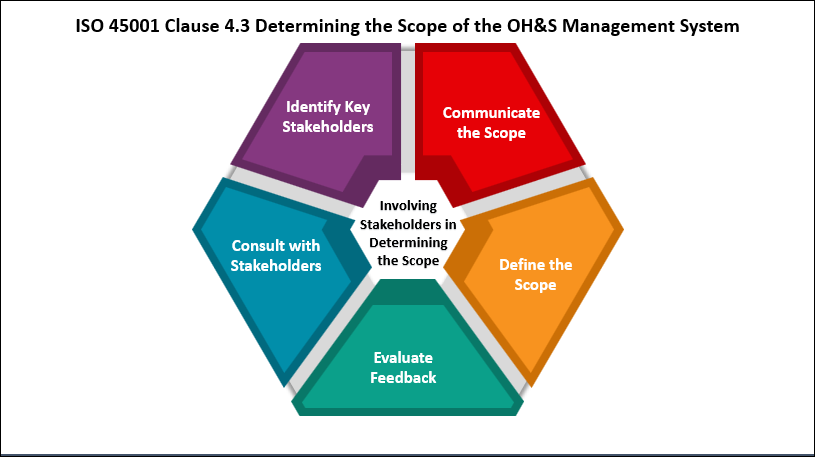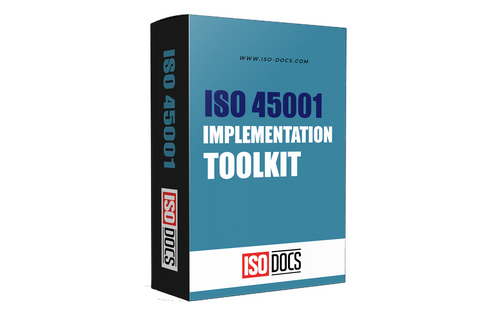ISO 45001 Clause 4.3 Determining the Scope of the OH&S Management System
Introduction
ISO 45001, the international standard for occupational health and safety management systems, outlines the requirements for organizations to establish, implement, maintain, and improve an occupational health and safety (OH&S) management system. One of the critical elements of implementing ISO 45001 is determining the scope of the OH&S management system. This process involves defining the boundaries and applicability of the system within the organization.
Understanding the scope is essential for effectively managing occupational health and safety risks. In this blog, we will provide an introduction to determining the scope of the OH&S management system as outlined in ISO 45001.

Importance of Defining the Scope in ISO 45001
Defining the scope of an Occupational Health and Safety (OH&S) management system is crucial in the ISO 45001 standard as it sets the boundaries and limits of what the system covers and does not. This is outlined in section 4.3 of the standard, which requires organizations to determine and document the scope of their OH&S management system.
Defining the scope of an Occupational Health and Safety (OH&S) management system is crucial as it delineates specific activities, processes, and locations to be included within the framework. This clarity is instrumental in encompassing all pertinent elements of health and safety within an organization while ensuring that critical aspects are not overlooked. Furthermore, a well-defined scope aids in eliminating potential ambiguities and misunderstandings regarding the system's objectives and intended outcomes.
A precisely articulated scope allows organizations to allocate resources optimally, establish clear objectives, and implement controls to mitigate risks and enhance occupational health and safety performance. Moreover, this definition declares the organization's dedication to managing health and safety risks in a structured and anticipatory approach. It communicates commitment to stakeholders—including employees, regulatory bodies, customers, and the public—reinforcing trust in organizational practices.
Articulating the scope of an OH&S management system under ISO 45001 standards plays a pivotal role by ensuring comprehensive coverage of health and safety concerns, preventing misinterpretations, facilitating efficient resource deployment, setting strategic goals, establishing control measures, and demonstrating organizational commitment to proactive risk management strategies.
Considerations for Establishing the Boundaries of the Management System
When determining the scope of the Occupational Health and Safety (OH&S) management system by ISO 45001, there are several key considerations to remember. Here are some essential factors to consider:
- Organizational Boundaries: Consider your organization's roles, responsibilities, and activities relevant to occupational health and safety. Identify the departments, functions, and locations that will be included within the management system's scope.
- Activities, Products, and Services: Determine the specific activities, products, and services within the scope of the OH&S management system. This includes considering the potential hazards and risks associated with these activities and how they may impact the health and safety of employees and other interested parties.
- Legal and Regulatory Requirements: Consider the legal and regulatory requirements regarding occupational health and safety that apply to your organization. Ensure that the management system is designed to meet these requirements and that any gaps are addressed within the system's scope.
- Organizational Context: Consider the internal and external factors that may influence the effectiveness of the OH&S management system. This includes factors such as the size and structure of the organization, its culture and values, and its relationships with stakeholders. Ensure that the scope of the management system is aligned with the organizational context.
- Stakeholder Expectations: Consider the expectations of stakeholders, including employees, contractors, customers, and regulatory authorities, regarding occupational health and safety. Consider how the management system can help meet these expectations and enhance trust and confidence in the organization.
By carefully considering these factors and ensuring that the scope of the OH&S management system is clearly defined and documented, organizations can establish a robust framework for managing health and safety risks and promoting a safe and healthy work environment for employees.
Involving Stakeholders in Determining the Scope
Involving stakeholders in determining the scope of the Occupational Health and Safety (OH&S) management system is essential for successfully implementing ISO 45001. Stakeholders have valuable knowledge and expertise that can help to identify potential hazards and risks within the organization.
There are several steps to involve stakeholders in determining the scope of the OH&S management system:
- Identify Key Stakeholders: This includes employees, management, suppliers, customers, regulatory bodies, and other relevant parties who are interested in the organization's health and safety performance.
- Consult With Stakeholders: Engage with stakeholders through meetings, surveys, interviews, and workshops to gather their input on the scope of the management system. Consider their concerns, priorities, and expectations.
- Evaluate Feedback: Review the feedback from stakeholders to identify common themes or areas of consensus. Consider how their input aligns with the organization's goals and objectives.
- Define the Scope: Use the input from stakeholders to define the boundaries of the OH&S management system, including the activities, processes, and locations that will be covered. Ensure that the scope is clear, relevant, and achievable.
- Communicate the Scope: Once it has been determined, communicate it to all relevant stakeholders, including employees, suppliers, and external partners. Make sure everyone understands their roles and responsibilities within the management system.
By involving stakeholders in determining the scope of the OH&S management system, organizations can ensure that their health and safety efforts are aligned with the needs and expectations of all parties involved. This collaborative approach can lead to a more effective and sustainable management system that protects the health and well-being of employees and stakeholders.
Documenting and communicating the scope
Determining the scope of the Occupational Health and Safety (OH&S) management system is a crucial step in implementing ISO 45001 standards. The scope of the system defines the boundaries and applicability of the OH&S management system within an organization.
To determine the scope of the OH&S management system, the following steps should be taken:
- Identify the internal and external factors affecting the organization's ability to achieve its occupational health and safety objectives.
- Consider the organization's activities, products, and services that are within the scope of the OH&S management system.
- Define the boundaries of the OH&S management system, specifying the locations, departments, processes, and personnel included.
- Identify the organization's relevant legal and occupational health and safety requirements.
- Consider the needs and expectations of interested parties, such as employees, customers, regulatory authorities, suppliers, and the community.
- Ensure that the scope of the OH&S management system is documented and communicated to relevant stakeholders within the organization.
By determining the scope of the OH&S management system, organizations can ensure that their occupational health and safety practices are effectively implemented, monitored, and improved by ISO 45001 standards. This helps protect employee's health and safety, reduce workplace accidents and injuries, and enhance overall organizational performance.
Conclusion
In the ISO45001 standard, one of the critical elements is the determination of the scope of the Occupational Health and Safety (OH&S) management system. This process, outlined in section 4.3 of the standard, is crucial for organizations to clearly define the boundaries and applicability of their OH&S management system.
Refining the scope is essential to ensure that the system effectively addresses the organization's risks and opportunities related to occupational health and safety. In this blog post, we will delve into the importance of refining the scope of ISO45001 and how it can lead to a more robust and effective OH&S management system.


